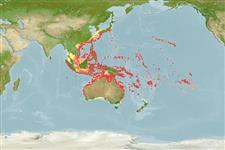Actinoptérygiens (poissons à nageoires rayonnées) >
Scorpaeniformes (Scorpionfishes and flatheads) >
Scorpaenidae (Scorpionfishes or rockfishes) > Pteroinae
Etymology: Pterois: Greek, pteron = wing, fin (Ref. 45335).
Environnement / Climat / Gamme
Écologie
; marin récifal; profondeur 2 - 55 m (Ref. 30874). Tropical; 22°C - 28°C, preferred ?; 43°N - 40°S, 95°E - 130°W (Ref. 55292)
Pacific Ocean: Cocos-Keeling Islands and Western Australia (Ref. 27362) in the eastern Indian Ocean to the Marquesas and Oeno (Pitcairn group), north to southern Japan and southern Korea, south to Lord Howe Island, northern New Zealand, and the Austral Islands. Replaced by the very similar Pterois miles from the Red Sea to Sumatra.
Length at first maturity / Taille / Poids / Âge
Maturity: Lm ?, range 16 - ? cm
Max length : 38.0 cm TL mâle / non sexé; (Ref. 2334); âge max. reporté: 10 années (Ref. 72479)
Épines dorsales (Total): 13; Rayons mous dorsaux (Total): 9-12; Épines anales 3; Rayons mous anaux: 6 - 8. Scales cycloid (Ref. 37816). Variable in color, usually in relation to habitat. Coastal species generally darker, sometimes almost black in estuaries. Often with large tentacles above eyes (Ref. 48635).
Inhabit lagoon and seaward reefs from turbid inshore areas to depths of 50 m. Often solitary, they hide in unexposed places at daytime often with head down and practically immobile. Pelagic juveniles expatriate over great distances and the reason for their broad geographical range (Ref. 48635). Hunt small fishes, shrimps, and crabs at night, using its widespread pectorals trapping prey into a corner, stunning it and then swallowing it in one sweep. Dorsal spines are venomous; the sting can be treated by heating the afflicted part and application of corticoids (Ref. 5503). A popular table fish.
Life cycle and mating behavior
Maturité | Reproduction | Frai | Œufs | Fécondité | Larves
Myers, R.F., 1991. Micronesian reef fishes. Second Ed. Coral Graphics, Barrigada, Guam. 298 p. (Ref. 1602)
Statut dans la liste rouge de l'IUCN (Ref. 115185)
CITES (Ref. 94142)
Not Evaluated
Utilisations par l'homme
Pêcheries: commercial; Aquarium: Commercial
Plus d'informations
RéférencesAquacultureProfil d'aquacultureSouchesGénétiqueFréquences alléliquesHéritabilitéPathologiesTraitementMass conversion
Outils
Articles particuliers
Télécharger en XML
Sources Internet
